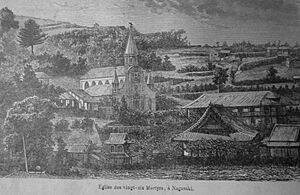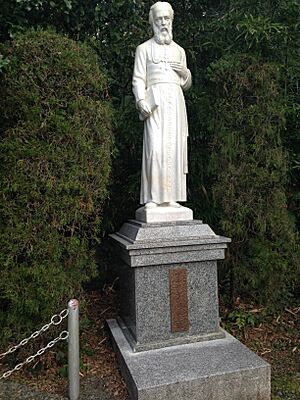Bernard Petitjean facts for kids
Bernard Thaddée Petitjean (born June 14, 1829 – died October 7, 1884) was a French Roman Catholic bishop. He worked as a missionary in Japan. He also became the country's first leader for the Catholic Church there, called a vicar apostolic.
Contents
Who Was Bernard Petitjean?
Bernard Petitjean was born in Blanzy-sur-Bourbince, France. He studied to become a priest in Autun. He became a priest on May 21, 1853. After that, he taught at a seminary and worked in a parish.
Becoming a Missionary
In 1856, he became a missionary. Missionaries are people who travel to spread their religious beliefs. He preached in many villages. In 1858, he worked with nuns. This experience made him want to join the Missions étrangères de Paris seminary. This group trains missionaries to go to other countries. Nine months later, he left for Japan.
Discovering Hidden Christians

He first stayed in the Ryūkyū Islands for two years. In 1863, he moved to Yokohama and then Nagasaki. Japan had recently opened its doors to foreigners again. It had been closed for many years.
Petitjean became a French teacher. He helped build a church dedicated to the Twenty-Six Martyrs of Japan. This church overlooked the sea. It opened on February 19, 1865.
A few weeks after the church opened, Petitjean met a special group of people. They were descendants of the Kakure Kirishitan, or "hidden Christians." These families had secretly kept their Christian faith alive for generations. They were drawn to the new church and its cross. They had hidden crosses in their own homes. Most were simple fishing people or artisans. They were careful when they met him, fearing trouble. Petitjean decided to visit their villages. By June 8, 1865, he had met 25 hidden Christians. They had kept their prayers, a cross, and met with an elder.
Facing Challenges in Japan
Pope Pius IX made Petitjean a bishop on May 11, 1866. He became the leader of the Catholic Church in Japan. He was officially made a bishop in Hong Kong on October 21.
However, the Japanese government soon began to persecute Christians. They imprisoned and even killed many. In 1868, new rules forbade Christianity. From 1869 to 1870, over 3,000 Christians were moved from Urakami to other parts of Japan. Many on the Goto Islands were jailed or tortured.
Petitjean was sent back to France in June 1868. He attended an important meeting of church leaders in Rome. He wrote to Japanese officials and the French government. But his efforts did not help much at first. The persecution of Christians ended in 1873. That year, Petitjean was allowed to return to Japan. At first, he could only give sacraments to foreign soldiers, sailors, and merchants.
Pope Pius IX sent him a special letter in May 1873. It expressed joy that the persecution had ended. It also noted that Japan was starting to allow some freedom for Christians.
Building the Church in Japan
Petitjean and another bishop, Laucaigne, had to build the Catholic Church in Japan from scratch. They sent missionaries to different places. Some missionaries focused on scholarly and scientific work. Nuns also came from France to help.
In late 1875, Petitjean went to Rome. He asked for his church area to be split into two parts: North and South Japan. He would lead the North. The South was given to another bishop, Pierre-Marie Osouf. Petitjean helped make Osouf a bishop in 1877.
Petitjean first lived in Osaka, where he built a church. Later, he returned to Nagasaki. He passed away in Nagasaki on October 7, 1884. He was buried in Oura Church.
His Legacy
By the time Petitjean died, Christianity had grown in Japan. There were 30,230 Christians. There were two bishops and 53 European missionaries. Importantly, there were also three Japanese-born priests. Petitjean had ordained them in 1882. They were the first Japanese priests ever. There were also two seminaries with 79 students and 65 schools with 3,331 pupils.
What Was His Coat of Arms?
A coat of arms is a special design that represents a person or family. Petitjean's coat of arms had:
- A red background.
- A statue of the Virgin Mary, wearing a crown. She was holding the baby Jesus.
- She stood on a cloud at the bottom of the shield.
- His motto was: Ipse conteret caput. (He will crush the head.) - Sancta Maria, ora pro nobis. (Holy Mary, pray for us.)



